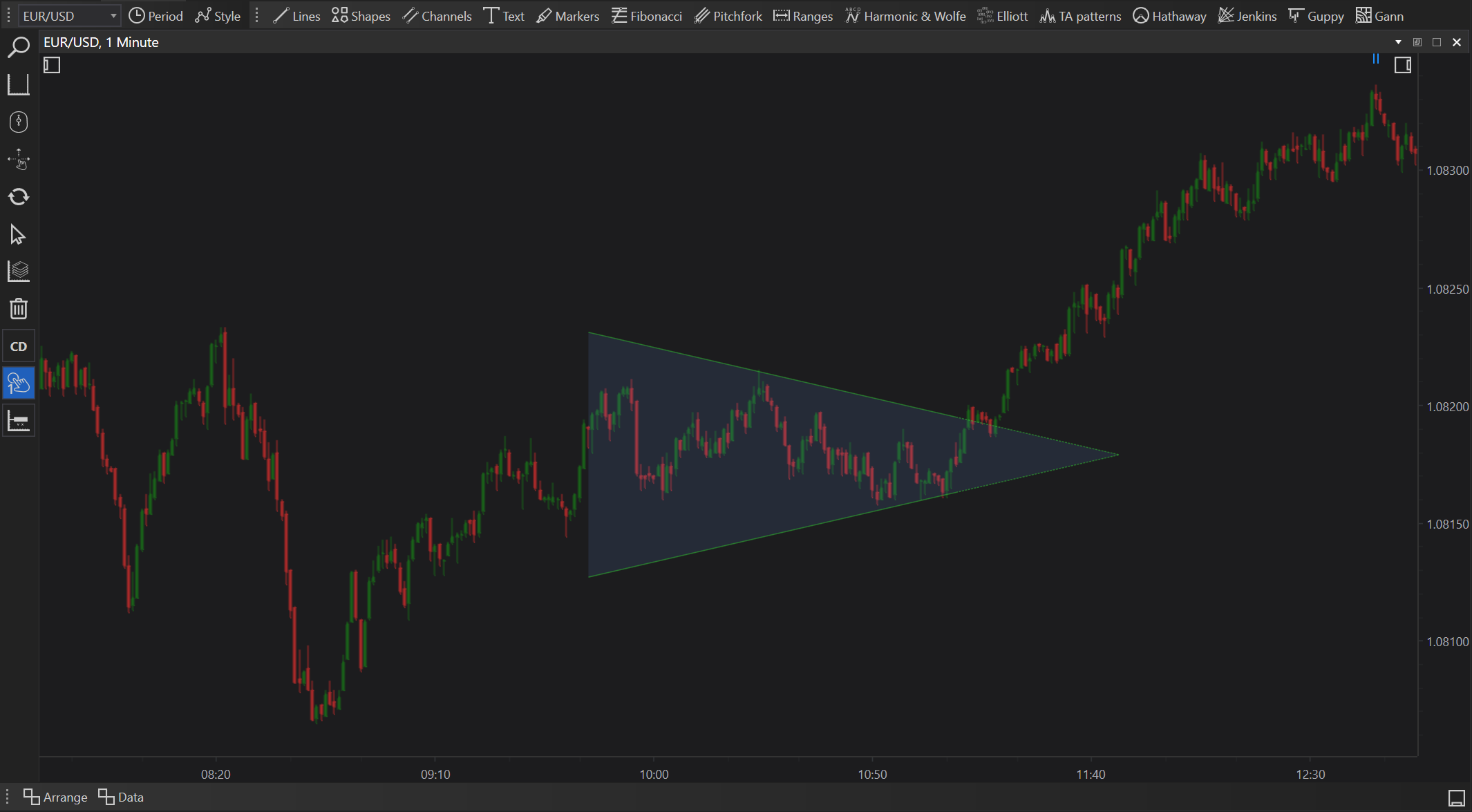- Accounts & Connection Management
- Data Management & Analysis
- Price Monitoring
- Charting
- Trading
- Scanners
-
Builders
-
Manual Strategy Builder
- Main Concept
- Operand Component
- Algo Elements
-
Use Cases
- How to create a condition on something crossing something
- How to create an indicator based on another indicator
- How to calculate a stop loss based on indicator
- How to submit stop order based on calculated price
- How to calculate a current bar price using a price type from inputs
- How to Use a Closed Bar Price
- Automatic Strategy Builder
-
Manual Strategy Builder
- Autotrading
- FinScript
- Trade Analysis
- Media Feeds
- Logs & Notifications
- UI & UX
Overview of the Symmetrical Triangle Pattern Drawing Tool
The Symmetrical Triangle pattern is a key technical analysis tool in FinStudio that identifies periods of consolidation where the price action converges to a point. This pattern is characterized by two converging trendlines with similar slopes, reflecting a balance between buyers and sellers before a likely breakout. It is typically considered a continuation pattern but can also act as a reversal signal depending on the market context.

Construction and Use
Select the Tool: Traders can access the Symmetrical Triangle pattern tool from the drawing tools menu in FinStudio, ideal for charts showing converging price action.
Initial Placement:
- Formation: The pattern forms by connecting at least two lower highs with a descending trendline and two higher lows with an ascending trendline, which converge to a point known as the apex.
- Completion: The pattern is considered to be potentially completing as the price approaches the apex of the triangle.
Drawing the Pattern: The tool helps traders visualize the convergence of the trendlines, highlighting the narrowing price range and potential breakout points.
Features
- Visualization: Clearly delineates the converging trendlines, aiding traders in recognizing and monitoring the development of the pattern.
- Flexibility: Effective across various asset classes and timeframes, suitable for both short-term trading and long-term investment strategies.
- Customization: Offers customization options for line color, thickness, and style, making it easier to distinguish the pattern on complex charts.
Practical Applications
Breakout Prediction:
- Use: Traders watch for a breakout from the triangle's boundaries, which is typically accompanied by an increase in volume. The direction of the breakout often signals the continuation or reversal of the trend.
- Benefit: Provides a clear trading signal with measurable targets and stop-loss points, enhancing trade execution.
Volume Analysis:
- Use: Volume tends to decrease as the symmetrical triangle forms, with an expected spike in volume at the point of breakout. This change in volume can confirm the pattern’s validity.
- Benefit: Enhances the reliability of breakout signals, allowing traders to make more confident decisions based on confirmed market movements.
Risk Management:
- Use: Establishing stop-loss orders just outside the opposite side of the breakout helps manage risk if the breakout direction reverses.
- Benefit: Protects trading capital by limiting potential losses and locking in profits as the market confirms the pattern's predicted direction.
Benefits
- Increased Predictive Accuracy: The Symmetrical Triangle pattern is valued for its ability to predict price breakouts, aiding traders in preparing for significant price movements.
- Strategic Trade Optimization: Allows traders to optimize their positions based on anticipated breakouts, improving the potential for profitable trades.
- Enhanced Market Understanding: Provides insights into the balance of power between buyers and sellers during periods of consolidation, offering deeper market analysis.
Conclusion
The Symmetrical Triangle drawing tool in FinStudio is an essential resource for traders who rely on pattern analysis to guide their market entries and exits. By accurately identifying and interpreting these patterns, traders can leverage their predictive power to enhance decision-making, align trading strategies with market dynamics, and achieve better trading outcomes. Whether used for anticipating market breakouts or for confirming trend continuations or reversals, the Symmetrical Triangle tool offers valuable insights that help traders navigate the complexities of various financial markets effectively.
- Accounts & Connection Management
- Data Management & Analysis
- Price Monitoring
- Charting
- Trading
- Scanners
-
Builders
-
Manual Strategy Builder
- Main Concept
- Operand Component
- Algo Elements
-
Use Cases
- How to create a condition on something crossing something
- How to create an indicator based on another indicator
- How to calculate a stop loss based on indicator
- How to submit stop order based on calculated price
- How to calculate a current bar price using a price type from inputs
- How to Use a Closed Bar Price
- Automatic Strategy Builder
-
Manual Strategy Builder
- Autotrading
- FinScript
- Trade Analysis
- Media Feeds
- Logs & Notifications
- UI & UX